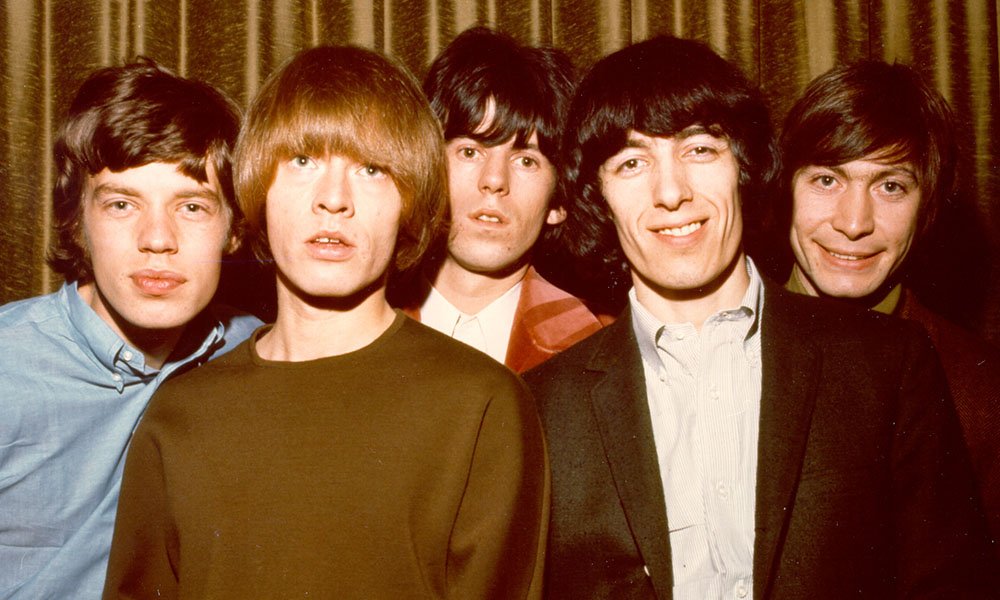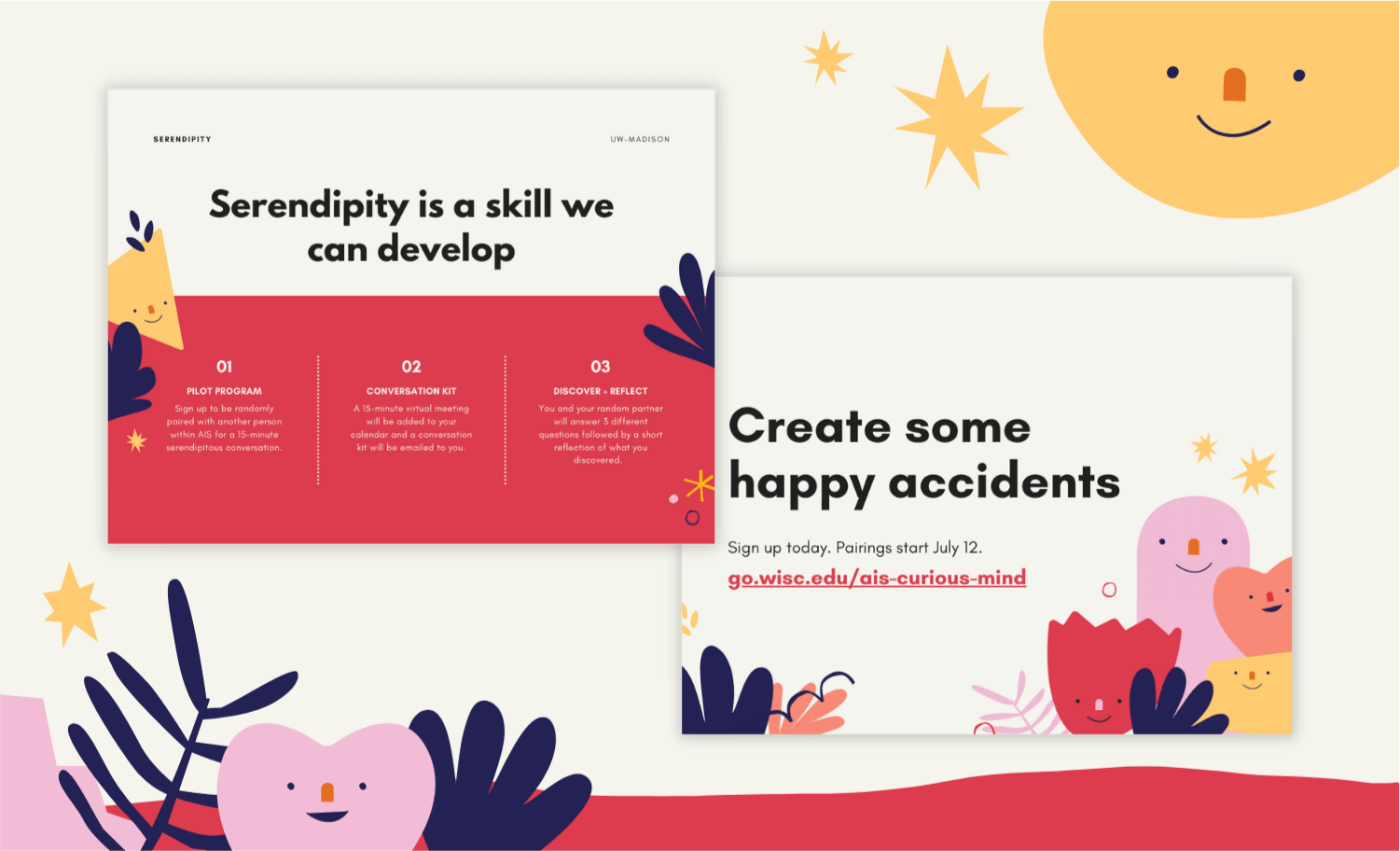Serendipity
I led Serendipity, a pilot program at UW-Madison, where coworkers were randomly paired for 15-minute guided conversations. The purpose was to improve social connections in a remote work setting, and motivate people to embrace the unexpected.
Challenge
Highlights
Role: Team lead, project manager, research, branding, prototyping, testing
Time: 8 weeks
Tools: Figma, Canva, Google Forms, Google Docs, Outlook, Microsoft Teams
When the pandemic began, our group of more than 60 individuals changed from working in the office to working remotely from home.
Recognizing how vital it is to create a sense of community in a virtual environment, I felt that encouraging conversation among team members was crucial for combating loneliness and sparking imaginative thinking.
I was inspired by popular team-building apps like Coffee Roulette to create Serendipity, and worked with five people from the department’s Fun Committee to plan, organize, and run the program.
Process
Research
How might we connect team members serendipitously without them having to put in much effort?
Design
Design a joyful brand and make it easy for other campus groups to replicate Serendipity.
Test
Test the experience and gather feedback from participants to improve future events.
Research
Horace Walpole circa 1700s
Horace Warlpole defined Serendipity in 1754 as “the faculty of making happy and unexpected discoveries by accident.” Although serendipity may be seem random, it’s actually a skill we can develop.
We can intentionally add more serendipity into our lives by putting ourselves in situations where we have to interact with others. Like talking to people we wouldn’t normally talk to, traveling, trying a new hobby, changing our daily routines, and following our own curiosities.
Evidence of happy accidents
History shows us that casual conversations and chance meetings can lead to surprising ideas and new discoveries. Think about where we'd be without Anesthesia or The Rolling Stones!
For us as designers and developers, it's important to understand that luck can be a factor in solving problems. If we increase social serendipity in our lives, we also improve our odds of stumbling upon groundbreaking ideas and solutions.
Anesthesia
The recreational use of nitros oxide at ‘laughing gas parties’ in the late 1700s led to the discovery of anesthesia .
The Rolling Stones
Mick Jagger and Keith Richards randomly struck up a conversation on Oct 17, 1961 at the Dartford Station in Kent, England.
Potato Chips
A customer complaint in 1853 at Moon's Lake House in New York led to the creation of the potato chip.
Market research
I looked at major networking apps to gain insight into how we might design the best experience for Serendipity.
Donut
Donut helps connects teams serendipitously through Slack for virtual coffee chats, peer learning, and more.
Tiny Talk
Tiny Talk makes it easy for friends, family, or teams to spontaneously connect for short, random, one-on-one video chats.
Hallway
Hallway helps remote teams bring back hallway chatter through spontaneous conversations
Lunchclub
Lunchclub is a networking app that uses AI and Machine Learning to match professionals for 1:1 introductions.
Key takeaways
After analyzing these products, I defined 4 simple requirements that would help make Serendipity successful.
Keep meetings to 15 minutes or less, so users don’t have to commit too much time in their workday to participate.
Learn more about each person and what inspires them to enable more meaningful conversations when people are paired together.
Remove the friction of arranging meetings by scheduling and finding the most suitable times for everyone involved.
Reduce social anxiety by providing users with a conversation kit to guide the session.
User journey
Keeping the project's goals and needs in focus, I mapped out the steps a user would take, from beginning to end, to sign up and participate in the Serendipity program.
This helped us see exactly what our users would experience at each stage, and what tasks our team has to tackle throughout the journey. Through this exercise, we also discovered the need for supporting materials like a sign-up form, survey, and clear communication points to make everything run smoothly.
For instance, we were able identify the importance of planning for situations where paired individuals might need to reschedule their meetings so that we're prepared to help them.
Design
Survey
I created a survey of potential conversation questions grouped by the categories Fun, Random, and Deep. I invited the Center for User Experience and our department Fun Committee to vote on their top 3 favorite questions in each category.
Conversation Kit
I took the most popular questions from each topic and put together the Serendipity Conversation Kit. This tool helps guide conversations between participants and encourages deeper, more meaningful discussions.
Branding
I used Canva to create a playful brand of cute, bubbly creatures that would feel fun and inviting. The goal was capture users’ attention effectively by making our communications and design stand out in comparison to the usual messaging people get at UW-Madison.
Communication
Together with the Fun Committee team and with backing from our leaders, I introduced the Serendipity pilot program to over 60 individuals during a monthly department meeting to encourage sign-ups.
After the sign-up deadline, we used an algorithm in Google Sheets to randomly pair people and made sure people with similar roles were not matched together to make conversations more interesting.
Testing, testing
Out of around 60 people in our department, we had 22 participants join Serendipity, making it a successful pilot program! We tested it within our department first to see if it could work and provide value in other departments at UW-Madison too. Would we do it again? Yes!
22 total participants
13 feedback responses
100% of users want to participate again
Feedback
What we heard from participants and what we would do differently next time.
User feedback
Provide physical conversations kits that include lunch, coffee, tea, or other goodies.
Schedule two chats back-to-back so users can meet more than one person.
Host more Serendipity events!
Next time
Set expectations for users about how to connect with one another after they meet.
It’s a lot of manual work to schedule meetings for participants; want to explore automated options.
“I think it would be nice to make an intentional effort to connect with people on a more personal level. Whether it's sharing about our personal lives or interests and passions as they relate to our work, it's fun to hear about how different people think about stuff.”
— Serendipity participant
















